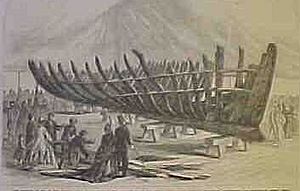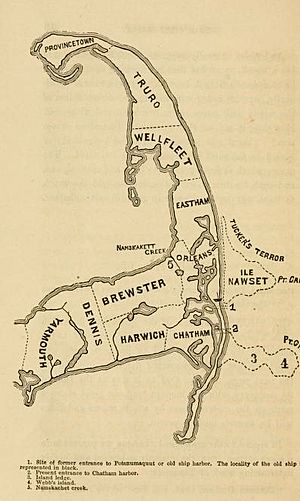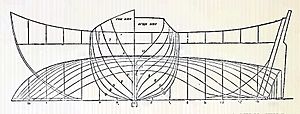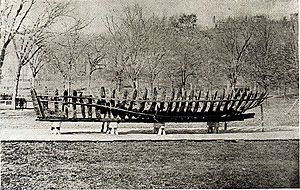Sparrow Hawk (pinnace) facts for kids
class="infobox " style="float: right; clear: right; width: 315px; border-spacing: 2px; text-align: left; font-size: 90%;"
| colspan="2" style="text-align: center; font-size: 90%; line-height: 1.5em;" | 
|} The Sparrow-Hawk was a small ship called a 'pinnace'. It was similar to another ship named Virginia. The Sparrow-Hawk sailed for the English Colonies in June 1626. It is the oldest ship from the first years of English settlement in the New World that we still have parts of today.
The ship had a very rough, six-week journey. It ended in a storm off Orleans, Massachusetts on Cape Cod. The Sparrow-Hawk was full of cargo and passengers. It was pushed onto the lonely Nauset Beach. Everyone on board survived and was taken to the nearby Plymouth Colony. Strong storms and moving sand quickly buried the wrecked ship. The Sparrow-Hawk stayed buried until storms in May 1863 uncovered its hull. The hull was then saved and put back together.
Some of the best ship designers in Boston in the 1860s helped rebuild the Sparrow-Hawk. The reconstructed ship was shown in many places over the next few years. We learned a lot from the Sparrow-Hawk. It taught us about how small pinnace ships were designed and built in the early 1600s.
Contents
- The Shipwreck on Cape Cod
- Rediscovering the Ship
- Ship Design and What We Learned
- Where You Can See It
- See also
The Shipwreck on Cape Cod
Wreck site of the Sparrow-Hawk in 1626 on Nauset Beach, Orleans, Massachusetts
The Sparrow-Hawk left London in June 1626. It was carrying passengers for the Jamestown Colony and Virginia. This ship was likely the smallest size a company would choose for an Atlantic crossing. Many passengers were not used to the vast ocean and its rough weather.
After six weeks, the Sparrow-Hawk reached the coast of Massachusetts. It was wrecked at Potanumaquut Harbor on Cape Cod. By the time it reached Cape Cod, the Sparrow-Hawk had run out of fresh water and beer. Captain Johnston was sick with scurvy in his cabin. At night, the Sparrow-Hawk hit a sandbar. The water was calm, so they dropped an anchor.
The next morning, they saw that the sealing material between the hull planks, called Oakum, had come out. Strong winds then pushed the Sparrow-Hawk over the sandbar and into the harbor. Many goods were saved, and no one lost their life.
Two survivors were guided to William Bradford, the governor of Plimouth Plantation. Two Native Americans who spoke English helped them. Governor Bradford sent a small boat with supplies to help repair the Sparrow-Hawk. The ship was repaired and set sail with its cargo. However, another strong storm pushed it ashore again. This time, the ship was too damaged to be fixed. The sailors and passengers moved to Plimouth Plantation. They stayed there for nine months. After that, they joined two other ships heading south to Virginia.
The Sparrow-Hawk was buried in the sand and marsh mud of a beach in Orleans, Massachusetts. This area became known as "Old Ship Harbor." The ship's burial spot had very little oxygen. This helped to keep the hull timbers in good condition. They were described as being free of worms and barnacles. All the metal parts had rusted away. The ship's keel and hull timbers could be seen from time to time when strong winds moved the sand on the beach. Visitors noticed a long, "tail-like" part sticking out from the back. Even though one strong storm can move sand six feet deep, it took several years for the Sparrow-Hawk to be completely buried. Its burial site kept the name Old Ship Harbor into the late 1800s.
Rediscovering the Ship
In 1863, a big storm between May 4 and May 6 uncovered much of the ship's hull. Solomon Linnell and Alfred Rogers from Orleans found it. On May 9, Leander Crosby visited the Sparrow-Hawk and took some items. The rudder was a few feet from the hull. It was taken, studied, and put back together. By August 1863, the Sparrow-Hawk was buried again for a few months. After that, it was uncovered once more. Then, it was moved above the high water mark.
There was great interest in the Sparrow-Hawk wreck. People immediately understood that this was the earliest known shipwreck from the time when the New England Colonies were first settled. When the hull was rebuilt, some disagreements started. The keel, hull planks, and rudder had been kept safe by the beach sand for over two hundred years.
Experts wondered how the builders could be sure about the ship's shape. For example, they said it had a "sheer" (the curve of the deck from front to back) of "two and one-half feet, with a lively rise at both ends." They also thought the ship had a single mast with a triangular sail. However, there is no proof that English ships of that time used such a single-masted design. Another English ship built in 1609 had similar measurements. Its keel was 33 feet long, its width in the middle was 16.5 feet, and its depth was 11 feet. If we compare these to the Sparrow-Hawk, its depth would be about 8 feet.
Ship Design and What We Learned
Hull lines of the Sparrow-Hawkas drawn by John Lawlor, around 1864
Experts Dolliver & Sleeper described the ship. They said that only a trained eye could see a small difference in its sides. This was because the ship had leaned to one side. They replaced parts like the keel, sternpost, and some hull timbers. The front part, top timbers, and deck were missing. But enough remained to guess its overall shape.
A model made by D. J. Lawlor, a famous Boston Naval architect, showed their idea of its form and size. Its front lines curved outwards, and its back lines were sharp and curved inwards. The middle section was almost a perfect circle. It had a square back end. It likely had side walls as far forward as the middle of the ship. The rest of the deck was probably protected by an open rail. The type of Sailing ballast found suggested a deeper hull than what was rebuilt. It also hinted that the ship had heavy masts. Grooved floor timbers showed that ropes were used to hold timbers in place.
Lawlor's plan showed the Sparrow-Hawk with two masts. The front mast had a single square sail. The mizzen mast (back mast) had a lateen sail. Another expert, Mr. Sanders, decided to use Lawlor's plan but make the ship's depth about 8 feet. Simple curves replaced the deck's "lively rise." Paintings of small square-stern ships from this time show an overhang at the back. They also show an outboard rudder, as Lawlor drew. Sanders' design considered the mast step (where the mast sits). This led to two possible mast setups: a simple three-masted ship, or a two-masted ship with square sails, known as a Barque in the 17th century.
Reconstructed hull of the Sparrow-Hawkon the 'Commons', Boston, Massachusetts
In 1980, an expert named Baker explained how hard it was to decide if a ship was a pinnace. There is still no full agreement on what type of ship the Sparrow-Hawk was. It had a deck and a square back, so it wasn't a shallop. Baker thought it was too wide to be a pinnace. Others called it a 'ketch'. However, the Nautical Archeology department at Texas A&M University calls the Sparrow-Hawk a pinnace. They believe it represents the 'small pinnace' design, different from the 'large pinnace' type.
Where You Can See It
The rebuilt Sparrow-Hawk hull was shown in several cities. This included Boston Common in 1865. It was then given to the Pilgrim Society in 1889. It was displayed there for over a hundred years. The Sparrow-Hawk hull was on a long-term loan to the Cape Cod Maritime Museum in Hyannis, Massachusetts. But it has since been returned to the Pilgrim Hall Museum, where it is stored.
The timbers are now being studied further. This research is done with maritime archaeologists from SEAMAHP.org. Experts in 17th-century ships and dendrochronology (dating wood using tree rings) are also helping. The shipwreck is planned to be displayed again soon.
See also
 In Spanish: Sparrow Hawk (pinaza) para niños
In Spanish: Sparrow Hawk (pinaza) para niños
| History | |
|---|---|
| Name | Sparrow Hawk |
| In service | June, 1626 |
| Out of service | July, 1626 |
| Stricken | Nauset Beach, Orleans, MA |
| Homeport | London, England |
| Fate | wreck |
| Status | Museum reconstruction. |
| Notes | Hull reconstruction owned by Pilgrim Society, now on long term loan to Cape Cod Maritime Museum. |
| General characteristics Profile | |
| Type | pinnace |
| Displacement | 30 tons |
| Length | 40 ft (12 m) |
| Beam | 12.83 ft (3.91 m) |
| Draft | 9.63 ft (2.94 m) |
| Speed | ? 2-7 knots |
| Range | offshore, ocean |
| Complement | 25 |
| Armament | None |
| Armour | None |
| Notes |
|




